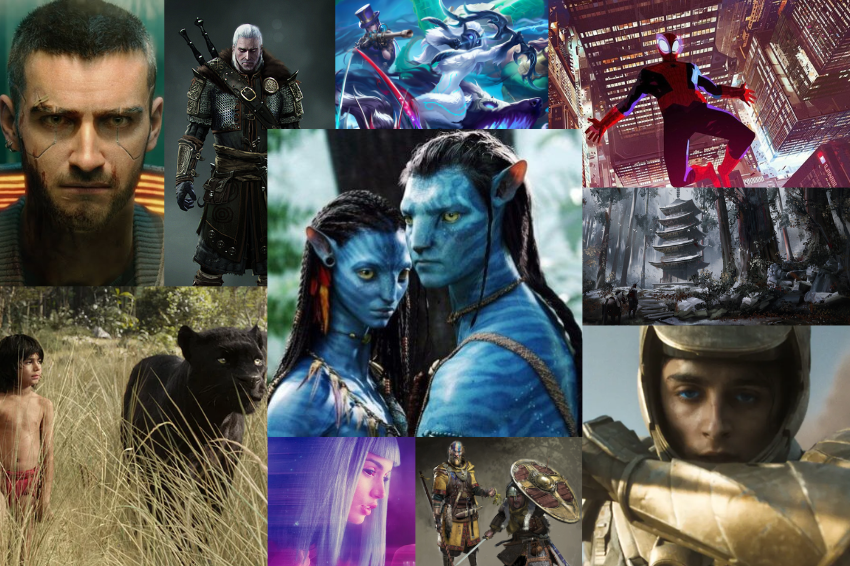CG artwork revolutionized our digital experience because it created new ways to view blockbusters in films and games alongside advertising concepts and designs. Advanced software tools enable artists to generate authentic-looking along with personalized fantasy images thus enabling new innovative creative avenues.

Different artists across the world continuously challenge their own imagination to create awe-inspiring virtual worlds and their corresponding characters and scenes that bring audiences to life.
The article explores the best CG artwork delivered by skilled creators whose work permanently shaped their professional fields. Artists use their masterpieces to demonstrate both technical-masterpiece and storytelling along with atmosphere formation and artistic visualization abilities.
The Best CG Artwork around the World
This article presents the best CG artwork by accomplished artists worldwide that reveal their creative methods and digital art contributions.
The Witcher 3: Wild Hunt – Concept Art by Marek Madej
As a Polish concept artist working for CD Projekt Red, Marek Madej designed essential components for the dark fantasy world of The Witcher 3: Wild Hunt. The game’s atmosphere of decay as well as its detailed designs were also created through his artwork.
Key Features of the Artwork
- Dark Fantasy Atmosphere: The concept art from Marek Madej successfully combines supernatural elements with medieval architectural designs into an atmosphere of dark fantasy.
- Attention to Detail: Through his attention to detail Madej brought to life both the collapsing castles and thick vegetation throughout the entire game landscape.
- Character Designs: Through his designs the Leshen and Crones became terrifying manifestations while maintained authentic realism.
Impact on Gaming
Hand-drawn concept art by Madej established future expectations in gaming development applications through its contribution to remarkable open-world role-playing game worlds.
Cyberpunk 2077 – Art by Kasia Redesiuk
Kasia Redesiuk, a concept artist at CD Projekt Red, developed the cyberpunk paradise Night City in Cyberpunk 2077 through his detailed work on the neo-dystopian metropolitan world with cybernetic upgrades and futuristic buildings.
Key Features of the Artwork
- Neon-Lit Urban Sprawl: Redesiuk’s designs successfully represent the disordered charm of low-life high-tech urban developments.
- Cyberware Aesthetics: From robotic limbs to holographic ads, every element feels futuristic yet believable.
- Cultural Fusion: The city blends American, Japanese, and Eastern European influences seamlessly.
Legacy in Sci-Fi Gaming
The artwork created by Redesiuk during the difficult game launch remains an influential cornerstone for cyberpunk visual representations in various media.
The Jungle Book (2016) – CGI by MPC
Moving Picture Company (MPC) made photorealistic CGI pictures for Jon Favreau’s The Jungle Book to bring alive all animated creatures and digital flora and wildlife.
Key Features of the Artwork
- Hyper-Realistic Animals: The virtual animals of Baloo and Shere Khan received such realistic fur texture treatment that they became virtually indistinguishable from real animals.
- Dynamic Environments: The developers spent time creating impressive detail work to depict the living jungle ecosystems together with waterfalls and cave systems.
- Seamless Motion Capture: Motion capture techniques enabled actors to record movements which transformed into natural animal behaviors during the capture process.
Impact on Film VFX
Through this film computers transformed into a complete alternative to the conventional live-action outdoor settings making way for a remake of The Lion King in 2019.
Blade Runner 2049 – Digital Environments by Andrew Schneider
Andrew Schneider brought his expertise as digital matte painter and environment artist to create the future cityscapes of Blade Runner 2049 which extended the original Blade Runner film’s cyberpunk design.
Key Features of the Artwork
- Atmospheric Lighting: The simulated world reaches its depth through dim skies along with glowing neon lights and suffocating mist which builds a dark yet engaging virtual space.
- Massive Scale: The apocalyptic Los Angeles presented to viewers extends throughout massive architectural buildings and dilapidated ruins which stretch indefinitely.
- Minimalist Yet Detailed: The director treated every cinematic composition as if it required the careful execution of a traditional artwork.
Influence on Sci-Fi Cinema
The futuristic visualization techniques in Blade Runner 2049 became the foundation for the development of Cyberpunk 2077 in video games.
League of Legends – Character Art by Gem “Lonewingy” Lim
Gem Lim who goes by the alias Lonewingy designs League of Legends’ most revered champions because he developed Ahri Jhin and Kai’Sa among others.
Key Features of the Artwork
- Stylized yet Detailed: Lim’s characters present an attractive anime look combined with highly detailed protective equipment and clothing details.
- Expressive Poses: Each champion in the game adopts poses that match their personality characteristics.
- Cultural Inspirations: Multiple elements from cultural traditions get integrated into her designs.
Impact on Gaming Culture
The distinctive visual appeal of League of Legends remains maintained through her artistic contributions to champion design.
Avatar: The Way of Water – CGI by Weta FX
Under the direction of Weta FX leader James Cameron, the company set new CGI standards through their work in Avatar: The Way of Water especially regarding underwater motion capture.
Key Features of the Artwork
- Underwater Realism: Funny-liquid simulation together with piercing lights and authentic Navi character movement applications created groundbreaking VFX standards.
- Pandora’s Ecosystem: The world of Pandora displays unforgettable alien appeal through its bioluminescent natural life and plants.
- Performance Capture Advancements: The advancement of performance capture technology enabled actors to present realistic movements during underwater performance scenes.
Legacy in Film VFX
Future blockbuster films will use the same approaches after the success of this film.
Assassin’s Creed Valhalla – Concept Art by Raphael Lacoste
Assassin’s Creed Valhalla creator Raphael Lacoste serves as the Art Director at Ubisoft where he produces picturesque landscapes as a core activity.
Key Features of the Artwork
- Epic Viking Aesthetic: The digital art possesses an epic Viking aesthetic through its extraordinary representation of snowy mountains alongside fjords and medieval villages.
- Historical Accuracy: The authenticity of his research about Norse architecture and clothing provides historical accuracy to the production.
- Dynamic Weather Effects: The game’s dynamic effects include real-time weather variations that combine storms with fog impacts as well as changes in environmental sunlight.
Influence on Open-World Games
The visual achievements in historical settings demonstrated by Lacoste showcase the same degree of beauty as fantasy landscapes.
Spider-Man: Into the Spider-Verse – Art by Alberto Mielgo
Alberto Mielgo served as the Spider-Man: Into the Spider-Verse visual consultant who contributed to creating its cinema graphics that followed comic book aesthetics.
Key Features of the Artwork
- 2D/3D Hybrid Animation: The film duplicates comic book sections through its implementation of halftone patterns with distinct border lines.
- Vibrant Colors: Every dimension possesses a separate distinctive color scheme that distinguishes it from others.
- Experimental Camera Angles: The film uses unconventional camera movements to improve scene action through dynamic perspective angles.
Impact on Animation
The successful outcomes from the film have motivated multiple production studios to adopt novel animation methods.
Dune (2021) – VFX by Paul Lambert
Paul Lambert headed the team that worked to create the virtual Arrakis located on the desert planet for the film Dune under his direction.
Key Features of the Artwork
- Gigantic Sandworms: The Sandworms appear lifelike because their movement and realism with textures both create an unnerving effect.
- Vast Desert Landscapes: The CGI production merges perfectly with authentic landscape settings which span over vast desert areas.
- Holographic Interfaces: The futuristic interfaces employ holographic technology to create technology that blends futuristic designs with contemporary styles.
Legacy in Sci-Fi Cinema
The ideal usage of CGI involves enhancing storytelling instead of taking focus away from it.
Ghost of Tsushima – Environmental Art by Ian Jun Wei Chiew
The breathtaking feudal Japan in Ghost of Tsushima was designed by Ian Jun Wei Chiew who works for Sucker Punch Productions.
Key Features of the Artwork
- Painterly Aesthetic: The gameplay duplicates the painterly elements which appear in traditional Japanese ink wash approaches.
- Dynamic Seasons: The gameplay together with the mood of players gets influenced by the way seasons and weather patterns change dynamically throughout the world.
- Authentic Architecture: The architectural elements of the temples along with villages and castles maintain accuracy to historical standards.
Impact on Game Design
Visual presentations in the game demonstrate that artistic quality enhances the gaming experience.
Conclusion
The digital art field today experiences a surge of talent because of the innovative CG artwork produced by artists. Artists who work with computer-generated visuals played a major role in designing successful industries using their creative skills. Upcoming CG artists benefit from the techniques mastered by these artists regardless of the specific elements they want to master.
CG artwork holds limitless potential in modern media because ongoing advances like AI along with real-time rendering technology and virtual production enable brand new possibilities. Who will transform digital art into something entirely new before the previous visionary?


